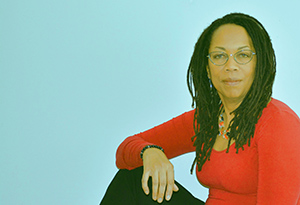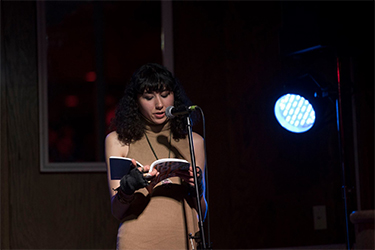Crossroads: Safiya Hopfe in Conversation with Gloria Blizzard

Volunteer Safiya Hopfe talks with Gloria Blizzard, winner of the 2023 Open Season CNF Award with her essay, “Passage” (featured in spring issue #222). They discuss Gloria's upcoming book of personal essays, living at multiple simultaneous intersections, and different art forms feeding each other.
Read an excerpt of “Passage” here.
Gloria Blizzard weaves multiple cultures, music, science and spirit with experiences as a Black Canadian woman of Caribbean heritage living on Indigenous lands of the Americas. She writes essays and poetry, as well as reviews and features on music, dance and film. Her work has appeared in The Humber Literary Review, byblacks.ca, cbc.ca, The Globe and Mail, The Conversation and many other publications. Her feature on musician Alanna Stuart was listed amongst Best Canadian Music Writing for 2022, and her essay "The Year of Jazz" was recently nominated by World Literature Today for the Pushcart Prize. She has an MFA from the University of King’s College, Halifax. Blizzard’s first book of essays will be published by Dundurn Press.
“Passage” zooms in and out, weaving broad themes of connectedness and alienation with personal memoir and scientific detail. Did this piece begin with your fascination with Kekulé’s discovery, with the image of the deer at the corner of Kingston and Markham Roads, with the shaman that told you that you are a bridge, or elsewhere?
This essay began with something that stayed with me since my time a Queens University when I took a course in Organic Chemistry. I never forgot the symmetry of the compound benzene and the idea that something that appeared so simple, clear and clean could also be toxic. Sometimes what appears to be comforting can be strange and alienating. A bit of symmetry is good, however, life is messy and shifts and flows and that is also good.
The fact of the rain stopping or starting depends on what is needed at the time. I have a book of personal essays coming out with Dundurn Press in 2024, with multiple subject matters and themes that are often woven together, but not always. There is no approach that is applied to all of them. Sometimes they start with a feeling that needs to be explored. For example, during the first lockdown, I recognized that the stillness I was experiencing both internally and in the external world was very similar to my experience of concussion. How I dealt with both scenarios resulted in the essay, “The Year of Jazz” (published in World Literature Today and nominated for the Pushcart Prize 2022). The impulse for another essay might be an incident or the mystery of a chemical compound.
The fragmentation of “Passage” feels deeply intentional and, to me, adds to its depth as a layered meditation on transition and relationality. In this sense, the structure of this piece seems to imitate its content. When, while you are writing an essay, does structural clarity usually emerge?
Sometimes structure seems clear at the onset and I might try it out with the subject matter to see if it works. At other times, the content indeed determines structure. The fact that I bring together multiple themes and stories is indicative to how I sit in the world. I live at multiple simultaneous intersections of experience, location, culture and race. I have studied science and engaged in the arts and spirituality. I don’t hold these things as separate. I experience them as all inherently connected. This place of crossroads is an integral part of my voice.
You work in multiple genres, and have an extensive portfolio of writing on music and the arts. As a poet, essayist, songwriter, and cultural critic, do you often work on multiple projects at once? How does this regular engagement with different forms inform your writing process and affect the way you write creative nonfiction?
I initially wrote poetry. Songwriting came later and was soon followed by writing reviews, essays and so on. I have written in different forms at different times in my artistic journey.
Being immersed in music, poetry and even dance has resulted in these artforms feeding each other. This interdisciplinary approach to being in the world is so valuable. It has resulted in me doing things like travelling to Brazil to do an intensive in Orixa Dance Movement which has provided me with new syntax, vocabularies and histories that show up in my writing.
My experiences in music as a singer/songwriter, bandleader and later, as part of a Brazilian percussion ensemble (bateria) are also important. With so much experience performing, writing, band leading, the recording process and other aspects of music, I connect with musicians and other artists with deep interest and understanding. This is very important when I write features or reviews on any aspect of culture. It also leads to an awareness and use of pacing, breath, pause and space in my essays. The space between the notes or in this case, the space between the words can be as important as the words themselves.
In “Passage” you write so poetically about science and nature. What inspires you to write about the natural world?
In the city a flower pushes up through the pavement. In “Passage,” a deer shows up in the middle of the suburbs. Nature is a part of us even though we often forget this. Connection to water, sea, animals, the wind is overtly and sometimes subtly a part of my work. We are not separate from our surroundings and each other. We just are not so good at staying integrated with nature and hence with ourselves. We are nature. We just sometimes forget this.
On the last page of this piece, you write about circling your way beyond and building “a different kind of bridge” over imposed limitations, like race. You go on to say, “Circling is my way through the seemingly untenable life of being a writer.” Can you elaborate on this idea?
I like to trust the reader to sit with ideas sometimes as opposed to explaining everything. I will say this though, the impulse to pull things from the ether, hold and consider them is very human, I think. The focus to thread them together for analysis and sharing beyond a conversation is something else entirely and takes a deep desire to do so. This can be an untenable choice in our culture. As a Black woman working in the arts in Canada, the Americas, the world, sometimes I’ve had to go around hurdles in my path and find new ways to get to the state I wish to sit within.

Safiya Hopfe
* * * * * * * *









